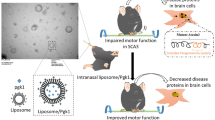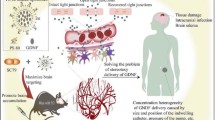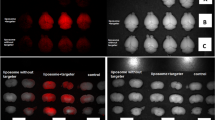Abstract
Cerebellar Purkinje cells (PCs) show conspicuous damages in many ataxic disorders. Targeted delivery of short nucleic acids, such as antisense oligonucleotides, to PCs may be a potential treatment for ataxic disorders, especially spinocerebellar ataxias (SCAs), which are mostly caused by a gain of toxic function of the mutant RNA or protein. However, oligonucleotides do not cross the blood-brain barrier (BBB), necessitating direct delivery into the central nervous system (CNS) through intra-thecal, intra-cisternal, intra-cerebral ventricular, or stereotactic parenchymal administration. We have developed a novel liposome (100 to 200 nm in diameter) formulation, DCL64, composed of dipalmitoyl-phosphatidylcholine, cholesterol, and poloxamer L64, which incorporates oligonucleotides efficiently (≥ 70%). Confocal microscopy showed that DCL64 was selectively taken up by brain microvascular endothelial cells by interacting with low-density lipoprotein receptor (LDLr) family members on cell surface, but not with other types of lipid receptors such as caveolin or scavenger receptor class B type 1. LDLr family members are implicated in brain microvascular endothelial cell endocytosis/transcytosis, and are abundantly localized on cerebellar PCs. Intravenous administration of DCL64 in normal mice showed distribution of oligonucleotides to the brain, preferentially in PCs. Mice that received DCL64 showed no adverse effect on hematological, hepatic, and renal functions in blood tests, and no histopathological abnormalities in major organs. These studies suggest that DCL64 delivers oligonucleotides to PCs across the BBB via intravenous injection with no detectable adverse effects. This property potentially makes DCL64 particularly attractive as a delivery vehicle in treatments of SCAs.




Similar content being viewed by others
References
Bird TD. Hereditary Ataxia overview. In: Pagon RA, Adam MP, Ardinger HH, et al., editors. GeneReviews® [internet]. Seattle: University of Washington, Seattle; 1998. [updated 2016].
Shakkottai VG, Fogel BL. Clinical neurogenetics: autosomal dominant spinocerebellar ataxia. Neurol Clin. 2013;31:987–1007.
Matilla-Dueñas A, Ashizawa T, Brice A, Magri S, McFarland KN, Pandolfo M, et al. Consensus paper: pathological mechanisms underlying neurodegeneration in spinocerebellar ataxias. Cerebellum. 2014;13:269–302.
Jacobi H, du Montcel ST, Bauer P, Giunti P, Cook A, Labrum R, et al. Long-term disease progression in spinocerebellar ataxia types 1, 2, 3, and 6: a longitudinal cohort study. Lancet Neurol. 2015;14:1101–8.
Bushart DD, Murphy GG, Shakkottai VG. Precision medicine in spinocerebellar ataxias: treatment based on common mechanisms of disease. Ann Transl Med. 2016;4:25.
Keiser MS, Monteys AM, Corbau R, Gonzalez-Alegre P, Davidson BL. RNAi prevents and reverses phenotypes induced by mutant human ataxin-1. Ann Neurol. 2016;80:754–65.
Scoles DR, Meera P, Schneider MD, Paul S, Dansithong W, Figueroa KP, et al. Antisense oligonucleotide therapy for spinocerebellar ataxia type 2. Nature. 2017;544:362–6.
McLoughlin HS, Moore LR, Chopra R, Komlo R, McKenzie M, Blumenstein KG, et al. Oligonucleotide therapy mitigates disease in Spinocerebellar Ataxia Type 3 mice. Ann Neurol. 2018. https://doi.org/10.1002/ana.25264.
Toonen LJ, Schmidt I, Luijsterburg MS, van Attikum H, van Roon-Mom WM. Antisense oligonucleotide-mediated exon skipping as a strategy to reduce proteolytic cleavage of ataxin-3. Sci Rep. 2016;6:35200.
Rodríguez-Lebrón E, Costa MD, Luna-Cancalon K, Peron TM, Fischer S, Boudreau RL, et al. Silencing mutant ATXN3 expression resolves molecular phenotypes in SCA3 transgenic mice. Mol Ther. 2013;21:1909–18.
Miyazaki Y, Du X, Muramatsu S, Gomez CM. An miRNA-mediated therapy for SCA6 blocks IRES-driven translation of the CACNA1A second cistron. Sci Transl Med. 2016;8:347ra94.
Ramachandran PS, Boudreau RL, Schaefer KA, La Spada AR, Davidson BL. Nonallele specific silencing of ataxin-7 improves disease phenotypes in a mouse model of SCA7. Mol Ther. 2014;22:1635–42.
Zhang N, Ashizawa T. RNA toxicity and foci formation in microsatellite expansion diseases. Curr Opin Genet Dev. 2017;44:17–29.
Seixas AI, Loureiro JR, Costa C, Ordóñez-Ugalde A, Marcelino H, Oliveira CL, et al. A pentanucleotide ATTTC repeat insertion in the non-coding region of DAB1, mapping to SCA37, causes spinocerebellar ataxia. Am J Hum Genet. 2017;101:87–103. https://doi.org/10.1016/j.ajhg.2017.06.007.
Khorkova O, Hsiao J, Wahlestedt C. Oligonucleotides for upregulating gene expression. Pharm Pat Anal. 2013;2:215–29.
Fiszer A, Olejniczak M, Switonski PM, Wroblewska JP, Wisniewska-Kruk J, Mykowska A, et al. An evaluation of oligonucleotide-based therapeutic strategies for polyQ diseases. BMC Mol Biol. 2012;13:6.
Corey DR. Synthetic nucleic acids and treatment of neurological diseases. JAMA Neurol. 2016;73:1238–42.
Lichota J, Skjørringe T, Thomsen LB, Moos T. Macromolecular drug transport into the brain using targeted therapy. J Neurochem. 2010;113:1–13.
Mathupala SP. Delivery of small-interfering RNA (siRNA) to the brain. Expert Opin Ther Pat. 2009;19:137–40.
De Souza EB, Cload ST, Pendergrast PS, Wah DWY. Novel therapeutic modalities to address nondrugable protein interaction targets. Neuropsychopharmacology. 2009;34:142–58.
Pardridge WM. shRNA and siRNA delivery to the brain. Adv Drug Deliv Rev. 2007;59:141–52.
Kreuter J, Gelperina S. Use of nanoparticles for cerebral cancer. Tumori. 2008;94:271–7.
Petri B, Bootz A, Khalansky A, Hekmatara T, Müller R, Uhl R, et al. Chemotherapy of brain tumour using doxorubicin bound to surfactant-coated poly(butyl cyanoacrylate) nanoparticles: revising the role of surfactants. J Control Release. 2007;117:51–8.
Khalin I, Alyautdin R, Wong TW, Gnanou J, Kocherga G, Kreuter J. Brain-derived neurotrophic factor delivered to the briain using poly (lactide-co-glycolide) nanoparticles improves neurological and cognitive outcome in mice with traumatic brain injury. Drug Deliv. 2016;23:3520–8.
Pardridge WM. The blood-brain barrier: bottleneck in brain drug development. Neurotherapeutics. 2005;2:3–14.
Méresse S, Delbart C, Fruchart JC, Cecchelli R. Low-density lipoprotein receptor on endothelium of brain capillaries. J Neurochem. 1989;53:340–5.
Dehouck B, Dehouck MP, Fruchart JC, Cecchelli R. Upregulation of the low density lipoprotein receptor at the bood-brain barrier: intercommunications between brain capillary endothelial cells and astrocytes. J Cell Biol. 1994;126:465–73.
Dehouck B, Fenart L, Dehouck MP, Pierce A, Torpier G, Cecchelli R. A new function for the LDL receptor: transcytosis of LDL across the blood-brain barrier. J Cell Biol. 1997;138:877–89.
Kuwahara H, Nishina K, Yoshida K, Nishina T, Yamamota M, Saito Y, et al. Efficient in vivo delivery of siRNA into brain capillary endothelial cells along with endogenous lipoprotein. Mol Ther. 2011;19:2213–21.
Yang ZZ, Li JQ, Wang ZZ, Dong DW, Qi XR. Tumor-targeting dual peptides-modified cationic liposomes for delivery of siRNA and docetaxel to gliomas. Biomaterials. 2014;35:5226–39.
Wang L, Hao Y, Li H, Zhao Y, Meng D, Li D, et al. Co-delivery of doxorubicin and siRNA for glioma therapy by a brain targeting system: angiopep-2-modified poly (lactic-co-glycolic acid) nanoparticles. J Drug Target. 2015;23:832–46.
An S, He D, Wagner E, Jiang C. Peptide-like polymers exerting effective glioma-targeted siRNA delivery and release for therapeutic application. Small. 2015;11:5142–50.
Demeule M, Régina A, Ché C, Poirier J, Hguyen T, Gabathuler R, et al. Identification and design of peptides as a new drug delivery system for the brain. J Pharmacol Exp Ther. 2008;324:1064–72.
Srimanee A, Regberg J, Hallbrink M, Vajragupta O, Langel U. Role of scavenger receptors in peptide-based delivery of plasmid DNA across a blood-brain barrier model. Int J Pharm. 2016;500:128–35.
Kim DH, Iijima H, Goto K, Sakai J, Ishii H, Kim HJ, et al. Human apolipoprotein E receptor 2. A novel lipoprotein receptor of the low density lipoprotein receptor family predominantly expressed in brain. J Biol Chem. 1996;271:8373–80.
Srivastava RA, Jain JC. Scavenger receptor class B type I expression and elemental analysis in cerebellum and parietal cortex regions of the Alzheimer’s disease brain. J Neurol Sci. 2002;196:45–52.
Göppert TM, Müller RH. Protein adsorption patterns on poloxamer- and poloxamine-stabilized solid lipid nanoparticles (SLN). Eur J Pharm Biopharm. 2005;60:361–72.
Lee S, Ashizawa AT, Kim KS, Falk DJ, Notterpek L. Liposomes to target peripheral neurons and Schwann cells. PLoS One. 2013;8:e78724.
White M, Xia G, Gao R, Wakamiya M, Sarkar PS, McFarland K, et al. Transgenic mice with SCA10 pentanucleotide repeats show motor phenotype and susceptibility to seizure: a toxic RNA gain-of-function model. J Neurosci Res. 2012;90:706–14.
McFarland KN, Ashizawa T. Transgenic models of spincerebellar ataxia type 10: modeling a repeat expansion disorder. Genes (Basel). 2012;3:481–91.
Boado RJ. Blood-brain barrier transport of non-viral gene and RNAi therapeutics. Pharm Res. 2007;24:1772–87.
Sakurai F, Nishioka T, Yamashita F, Takakura Y, Hashida M. Effects of erythrocytes and serum proteins on lung accumulation of lipoplexes containing cholesterol or DOPE as a helper lipid in the single-pass rat lung perfusion system. Eur J Pharm Biopharm. 2001;52:165–72.
Ogris M, Brunner S, Schuller S, Kircheis R, Wagner E. PEGylated DNA/transferrin_PEI complexes: reduced interaction with blood components, extended circulation in blood and potential for systemic gene delivery. Gene Ther. 1999;6:595–605.
Sempf K, Arrey T, Gelperina S, Schorge T, Meyer B, Karas M, et al. Adsorption of plasma proteins on uncoated PLGS nanoparticles. Eur J Pharm Biopharm. 2013;85:53–60.
Price TO, Farr SA, Yi X, Vinogradov S, Batrakova E, Banks WA, et al. Transport across the blood-brain barrier of pluronic leptin. J Pharmacol Exp Ther. 2010;333:253–63.
Gelperina S, Maksimenko O, Khalansky A, Vanchugova L, Shipulo E, Abbasova K, et al. Drug delivery to the brain using surfactant-coated poly (lactide-co-glycolide) nanoparticles: influence of the formulation parameters. Eur J Pharm Biopharm. 2010;74:157–63.
Singh-Joy SD, McLain VC. Safety assessment of poloxamers 101, 105, 108, 122, 123, 124, 181, 182, 183, 184, 185, 188, 212, 215, 217, 231, 234, 235, 237, 238, 282, 284, 288, 331, 333, 334, 335, 338, 401, 402, 403, and 407, poloxamer 105 benzoate, and poloxamer 182 dibenzoate as used in cosmetics. Int J Toxicol. 2008;27:93–128.
Gutiérrez-Puente Y, Tari AM, Stephens C, Rosenblum M, Guerra RT, Lopez-Berestein G. Safety, pharmacokinetics, and tissue distribution of liposomal P-ethoxy antisense oligonucleotides targeted to Bcl-2. J Pharmacol Exp Ther. 1999;291:865–9.
Tari AM, Gutiérrez-Puente Y, Stephens C, Sun T, Rosenblum M, Belmont J, et al. Liposome-incorporated Grb2 antisense oligodeoxynucleotide increases the survival of mice bearing bcr-abl-positive leukemia xenografts. Int J Oncol. 2007;31:1243–50.
Acknowledgments
We are grateful to the technical support provided by University of Florida (UF) ICBR Cytometry Core, ICBR Electron Microscopy Core, MBI-UF Cell & Tissue Analysis Core, UF Molecular Pathology Core, and UF Animal Care Services.
Funding
This study was supported by UF Opportunity Grant to ATA and TA.
Author information
Authors and Affiliations
Corresponding author
Ethics declarations
Conflict of Interest
ATA is an employee and stock holder of Bio-Path Holdings, Inc. TA is Adjunct Professor of Baylor College of Medicine, and receives grants from the NIH (R01 NS083564), the National Ataxia Foundation (NAF), the Myotonic Dystrophy Foundation (MDF), and the Marigold Foundation, and has been supported by Biohaven Pharmaceuticals and Ionis Pharmaceuticals for clinical trials of their drugs, and by Pacific Biosciences for symposium honoraria. TA also serves on the Medical and Research Advisory Board of the NAF, and the Scientific Advisory Board of the MDF. ATA and TA filed a US patent application (Serial # 14/390,584).
Research Involving Animals
The animal research in this work was approved by the UF Institutional Animal Care and Use Committee (IACUC #201307878).
Research Involving Human Participants
This work does not involve human subject research.
Electronic Supplementary Materials
Supplementary Figure 1
Caveolin-1 did not affect DCL64 liposomes binding to BMECs. BMECs were incubated in the absence (left panel) or presence (right panel) of 1.0 μg of peptides specific for caveolin-1 (Abcam) for 1 h before incubated with 0.5 μg of fluorescent liposomal oligonucleotides [red color] for an additional hour. Cells were fixed and counterstained with DAPI. (PNG 759 kb)
Supplementary Figure 2
Intravenous injection of DCL64 liposomes led to oligonucleotide accumulation in PCs. Mice were injected with fluorescent DCL64 and euthanized 4 h postinjection. (Left) Calbindin staining of Purkinje cells [green color]; (Right) Detection of red fluorescent oligonucleotide in cerebellar Purkinje cells and dendrites in the molecular layer. (PNG 1629 kb)
Rights and permissions
About this article
Cite this article
Ashizawa, A.T., Holt, J., Faust, K. et al. Intravenously Administered Novel Liposomes, DCL64, Deliver Oligonucleotides to Cerebellar Purkinje Cells. Cerebellum 18, 99–108 (2019). https://doi.org/10.1007/s12311-018-0961-2
Published:
Issue Date:
DOI: https://doi.org/10.1007/s12311-018-0961-2




